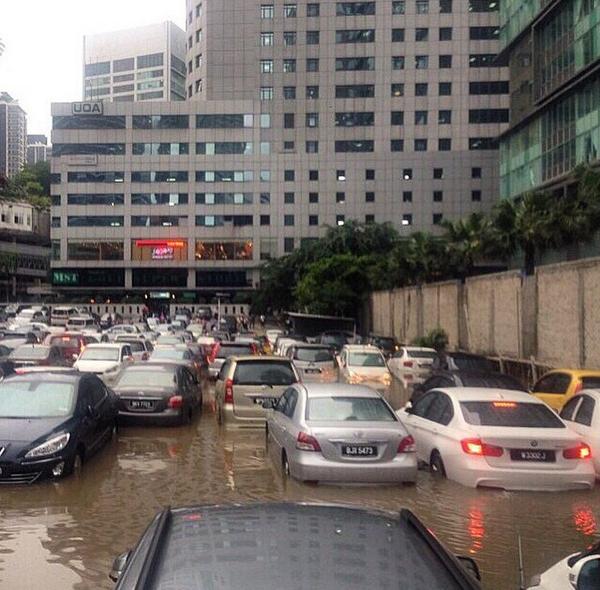 Source: Davies, R., 2014
Source: Davies, R., 2014Kuala Lumpur, the capital of Malaysia was founded as a mining town in 1857, and has grown continuously into a sprawling city with a population 7.5 million people in the greater metropolitan area. Since independence in 1963, Malaysia has grown into a major economic center, and trade hub with GDP growing at over 5% in 2015.
The city was named Kuala Lumpur or ‘muddy confluence’ as it is located in the Sungai Kelang flood plains, between a mountainous region to the north and east, and the Malacca Strait to the west. Eleven tributary rivers that are sourced from the adjacent mountainous regions feed the Sungai Kelang. There is a steep topography surrounding Kuala Lumpur as it is at the bottom of a basin that is at sea level.
Located in a tropical rainforest, Malaysia receives heavy rainfall during the wet season from October to March. The tributary rivers flowing from the mountainous areas around the city funnel and multiply intense rains to flash flood the city located at a lower elevation. The expansive development of roads and buildings has increased the impervious surfaces, which prevent rainfall from returning to groundwater. This additional rainfall runoff has increased the intensity of flash floods. Presently there is no effective warning system for flash flooding throughout the city.
Kuala Lumpur is has a significant number of residents who live on the periphery of the city in informal settlements. This marginalized population is most at risk of impacts from flooding, as most of their homes are situated along the rivers, where there is adequate vacant land, which planners left undeveloped to form a natural barrier against flooding. The highest densities of these informal settlements are on the periphery of the city with substandard infrastructure and a general lack of access to public services.
As a thriving economic center, Kuala Lumpur has a high capacity to address the pressing flooding hazards. Since the 1970’s the government has engaged in various projects to contain flood damage. Opened for city-scale use in 2007 the Stormwater Management And Road Tunnel (SMART) tunnel is an example of high adaptive capacity in Kuala Lumpur. SMART is a multi-use tunnel stretching 9.7km that serves as both a road for light automobile traffic, but also as a floodwater bypass tunnel when flooding occurs, which diverts water away from the Central Business District. With an initial construction cost of US$514M, this project was funded through a Public-Private Initiative. The Malaysian Government funded US$342M, with the rest supplied by Gamuda, who in turn received a 40-year concession for the tolls collected from tunnel traffic. SMART averages 30,000 cars per day and has been used successfully for flood bypass 44 times.
To adapt to the floods in Kuala Lumpur there is need to aggregate and project implementation. To scale the adaptation solutions, a policy scheme must be implemented to coordinate efforts. This policy mandate should be housed under the Public Works Department, with a directive to address long-term organized flood prevention and response. This policy mandate will have a few specific actionable steps. First, the Public Works Department should conduct a comprehensive city plan to locate appropriate areas for additional SMART tunnels. These additional tunnels would be planned to divert high capacity of floodwater. Again, the funding for these tunnels will rely on Public-Private financing so the tunnels can alleviate traffic congestion as well.
In addition to SMART infrastructure, this city plan would include a mandate for allocating green spaces to complement pavements. These islands of vegetation will be added to help alleviate the rainfall runoff, as the restored ecological landscape will provide more absorbent surfaces. As new municipal pavement is laid in expansion projects and repairs of current roads, we recommend relying on permeable concrete, reducing runoff.
The Kelang and other river tributaries must continue to be dredged to remove solid waste and sediments. When the river systems are adequately dredged, they will have a higher water flow capacity. Similarly, this policy must sanction against dumping solid waste into the rivers. For this regulation to be effective, the Solid Waste Management Department must expand solid waste and recycling collection throughout the entire greater metropolitan area, including informal settlements.
This article is a product of Professor Shagun Mehrotra’s Climate Change and Cities class. Analysis is based on the Framework for City Climate Risk Assessment and Climate Change and Cities:First Assessment Report of the Urban Climate Change Research Network. Views expressed are entirely those of the authors.
References
Elsayed, I.S.M. (2012). Effects of population density and land management on the intensity of urban heat islands: A case study on the city of Kuala Lumpur, Malasyia. Intech. Retrieved from: http://www.intechopen.com/books/application-of-geographic-informationsystems/effects-of-population-density-and-land-management-on-the intensity-of-urban-heat-islands-a-case-stud
Flooding at Bay K14 at Kuala Lumpur International Airport’s new budget terminal. Retrieved from http://www.bloomberg.com/news/articles/2015-0726/kuala-lumpur-s-1-billion-air-terminal-is-sinking-airline-says
Flood maps of Kuala Lumpur. Retrieved from: www.Floodmap.net
Kuala Lumpur, Date & Time Info. Retrieved from: http://dateandtime.info/citycoordinates.php?id=1735161
Kuala Lumpur City image. Retrieved from: http://www.paralympic.org/news/kuala-lumpur-stage-laureus-world-sports-awards
Report on Characteristics of Household 2010 Report. Department of Statistics Malaysia, Official Portal (2015). Retrieved from: https://www.statistics.gov.my/
Maps of Kuala Lumpur and region. Retrieved from: https://cartodb.com/
Map of Malaysia. 2015 Google Maps. Retrieved from:https://www.google.com/maps/
New Geography, The Evolving Urban Form: Kuala Lumpur. Retrieved from: http://www.newgeography.com/content/003395-the-evolving-urban-formkuala-lumpur
The Star Online News. Retrieved from: http://www.thestar.com.my/News/Community/2014/05/28/Dont-blame Smart-Tunnel-DID-Flash-floods-in-the-city-caused-by-clogged-drains-and heavy-rainfall-not/
The Star Online News. Retrieved from http://www.thestar.com.my/News/Nation/2012/06/06/Garbage-problem at-chronic-level-says-SMART/
Water ponding that has raised safety concerns can be seen at the low-cost terminal klia2, Sepang, November 27, 2014. — Picture by Saw Siow Feng. Retrieved from: http://www.themalaymailonline.com/money/article/after-scrutinyairport-operator-says-klia2-cost-below-rm4b
World Economic Forum, Global Competitiveness Report 2014-2015. Retrieved from: http://reports.weforum.org/global-competitiveness-report-2014-2015/
World Economic Forum, Global Competitiveness Report 2015. Retrieved from: http://reports.weforum.org/global-competitiveness-report-2014-2015